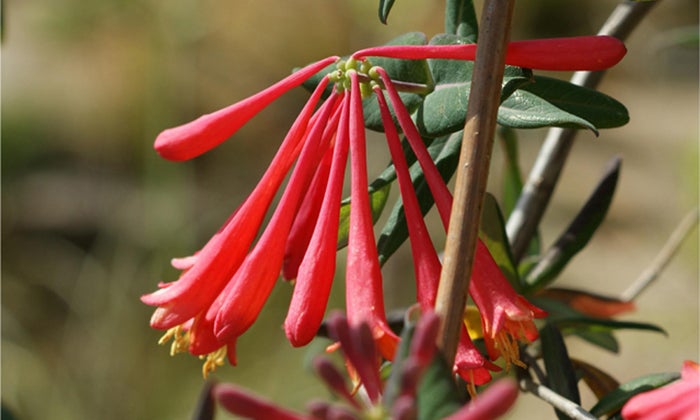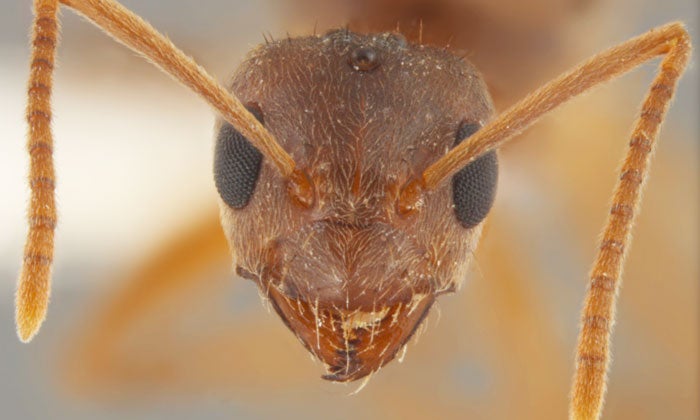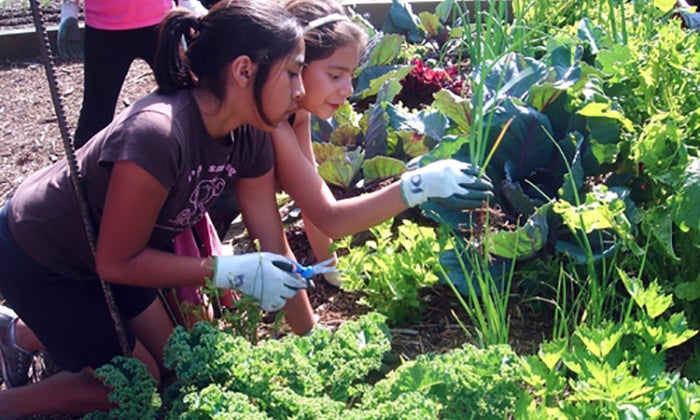5 Things Scientists Say to Try in Your Yard This Spring

With spring gardening season in full swing, Natural Sciences researchers have suggestions for the perfect vegetable garden, flower bed, lawn or landscape. In fact, scientists with the University of Texas at Austin can help you do more than have a great looking and productive yard: they've got tips that would help the local environment and maybe even the gardeners themselves.
1. Choose native plants over invasive species.
Non-native invasive species crowd out native species and decrease biodiversity, even rendering the landscape less hospitable for local wildlife.
According to a recent study by University of Texas biologist Norma Fowler, the longer an area has been settled the more invasive plants are found. That's because many invasive plants – ligustrum, Japanese honeysuckle and chinaberry, for example — routinely wind up in home landscaping (they're even sold at local garden centers), but they are escape artists. You may plant them in your yard, but they spread beyond your property.
Xeriscaping, or landscaping that requires little or no water, has gotten more popular in Texas, in part because it's environmentally friendly and because for most land-owners it saves on watering costs. (Another bonus: it requires much less yard-work.) Even without water, non-native plants, though, can spread.
Find recommended native alternatives to invasive plants for lawns and xeriscaping at the bottom of this article.
2. Plant for pollinators.
The plants we put in our gardens can be a big help to our native insects. Texas bees, flies, wasps, moths and butterflies are an important part of a healthy ecosystem and native plants serve their needs best.
Shalene Jha, an associate professor of integrative biology, studies the connection between native pollinators and plants. Pollinators need two things: food and shelter. Since 70 percent of native bees nest in the ground, it's important to leave some soil bare and undisturbed. The other 30 percent of native bees are cavity nesters and depend on dead trees, rock crevices and logs for nests. Native flowers with conspicuous blooms are favorite foods.
As for butterflies and moths, many of them lay their eggs on native plants, such as milkweed. Choose plants with inconspicuous flowers and plant a mix of spring and fall blooming plants.

3. Repel pests with some forethought.
Biologists Larry Gilbert and Rob Plowes are among the scientists in the Invasive Species Research Lab at the Brackenridge Field Laboratory studying ways to prevent certain invasive pests, like tawny crazy ants, from growing out of control. Gilbert says these bugs ride in on potted plants and mulch delivered from elsewhere, so it's important to look closely at anything purchased from nurseries and garden centers. If there are signs of small, brown, crazy-moving ants that look like this, beware.
For other pests, Plowes recommends managing your landscape with an understanding of the preferences of the potential pest species. For example, fire ants (and other weedy species) establish in disturbed areas with bare ground or low plant cover. Fire ant colonies can be degraded with injections of very hot water, he says.
Welcoming more biodiversity is another good idea: bats and small mammals that eat mosquitos and other pests and native plants that attract birds and bugs. It's a good idea to avoid herbicides and pesticides, experts say, too, since they can repel plants and animals you want to keep around.
"If you have a specific pest and it seems to dominate the landscape, it is an indication that you don't have enough diversity of both plant and insect community," said Leslie Uppinghouse of the Lady Bird Johnson Wildflower Center. "By adding plants that draw in birds, bees, bats, and bugs, the natural predator and prey balance can be restored. In order to do that, you need water, shelter and food for all."
4. Consider a root-microbe transplant.
In 2015, integrative biology professor Ulrich Mueller discovered a cheap and easy way to engineer healthier, faster-growing plants. He harvested the microscopic life—or microbiomes—from the roots of the healthiest plants in a set and transplanted drops of them onto seedlings 2-4 days old.
You can watch a video about how Mueller conducted his study, and, if you're really ambitious, try his simple four-step process with your next batch of seedlings. Anyone "can potentially use these methods to improve growth and health of crops," Mueller said.

5. Garden with children.
According to research from Jaimie Davis, a nutritional sciences researcher with the University of Texas at Austin, gardening with your kids might make them healthier. Davis found that children who were taught about gardening, growing food and cooking as part of an afterschool program saw reductions in obesity, body mass index, waist circumference and increases in dietary fiber and vegetable intake.
"Getting kids back to those roots, getting their hands in the soil, planting the seed, harvesting and preparing the food, it seems to be very effective at changing behavior and encouraging healthy eating," Davis said.
Davis recommends growing herbs like basil, mint, dill and fennel, since they grow quickly and can be used in lots of dishes; radishes, since they grow quickly, which is attractive for kids to watch; and tasty fare like tomatoes and berries.
More Tips from the Experts
UT biologists and experts with the University's Lady Bird Johnson Wildflower Center offered several alternatives to common invasive plants that look just as good in Central Texas landscaping as their invasive counterparts and don't contribute to environmental degradation.
Instead of these invasive plants...
Glossy Privet (Ligustrum lucidum), an ornamental evergreen tree with glossy green leaves and pungent white flowers that can drive some native plants to extinction by blocking light.
Plant these native alternatives...
Wax Myrtle (Morella cerifera) an evergreen and drought tolerant shrub that thrives in urban environments and has a spicy fragrance, as well as pale blue berries that birds enjoy and that can be boiled to make wax for candles.
Chinese Privet (Ligustrum sinese), an evergreen shrub with white flowers and clusters of purple or black berries
Yaupon Holly (Ilex vomitoria), a drought- and cold-tolerant shrub with white flowers and clusters of red berries that birds and animals like and that can be used in tea (the flavor is similar to yerba mate).
Japanese Honeysuckle (Lonicera japonica), a twining and fast-growing vine with oval leaves, white, sweet-smelling flowers that fade to yellow and spherical black berries, that spreads aggressively and can choke native trees and shrubs, harming forests
Coral honeysuckle (Lonicera sempervirens L) is a less aggressive vine with red tubular bloom you can eat and a sweet smell, attractive to butterflies, hummingbirds and other birds.
Chinaberry (Melia azedarach), an ornamental tree, has seeds that are toxic to humans and yellow berries that lead to slippery sidewalks when they fall in the spring.
Soapberry (Sapindus saponaria), also has yellow berries that can be toxic to humans if eaten, but the berries can be used for soap and the tree itself is hardy, drought tolerant and good for city landscapes.
Heavenly Bamboo (Nandia domestica) is not actually bamboo, but an evergreen and toxic shrub with small clusters of red berries that are especially toxic to cats, and red or pink leaves that turn green.
Evergreen sumac (Rhus virens) is a drought-tolerant, hardy evergreen shrub with early pink leaves that turn green, small white flowers and red berries that can be used to make tea and that attract wildlife and butterflies.
Several invasive plants commonly used in xeriscaping: pampas grass and ornamentals like cat's claw vine, scarlet firethorn.
Native plants that are better for Texas xeriscaping: Mexican feathergrass (nassella tenuissima), Desert spoon (Dasylirion wheeleri), Desert Willow (Chilopsis linearis) and Cardinal's feather (Acalypha radians).



